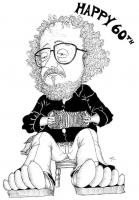-
Posts
3,484 -
Joined
-
Last visited
Everything posted by Chris Timson
-
This isn't practical, just a vagrant thought I had. Percy Honri always used to describe himself as a Concert-in-a Turn. As it's the seaside, how about A Concertina Tern? Back to the plot: - Oh I do like to squeeze beside the seaside - Hold me gently, squeeze me tight - What do you do with a drunken sailor? Chris
-
A few suggestions, I'll put more up when I have time ... - Jody Kruskal Waves It About - Only When I Squeeze - Concertina Shell-Out - Music For A Beached Concertina - Concertinas Are So Bracing Chris
-
Living as I do with a fiddler, I can tell you that this is another instrument with high complexity on both hands. The left hand fingering has to be precise, but so does the right-hand bowing. The soul of the fiddle is in the bowing, the precision of the note is in the fingering. So few fiddlers bother to change hands. You can't restring a fiddle for left handed use either since they are assymetrical in cross section. Chris
-
I found a concertina loud enough for me to hear what I was playing without bending over it even in a large session helped a lot because I stopped bending over it! Chris
-
From what I've seen with English music left handers tend to head for C/G boxes because this puts a lot of the melody on the left hand, while right handers like me go for G/D's because the melody is largely on the right. Dunno so much about Irish, but have a feeling that on the C/G the melody is well shared between the hands so handedness is not an issue. Others will have to speak for other musical styles but in general I don't think I agree with the suggestion that the anglo favours right-handers. Chris
-
It was a fine cake. There were three pieces left over at the end which Anne and I savoured over the next couple of days. It's making is a tale, which as told by Anne, for simple brevity and lack of incident is rivalled only by Lord of the Rings. Ask Anne to tell you if you'vr got an afternoon to spare. It doesn't stop there. On Friday Annette Shilling spent several hours eyeing me up from a distance, which I found concerning ... At the end she gave me this: I should like to point out I only take size 9 shoes. Chris
-
In the interests of pedantry it was actually the Radway Inn. I had a superb Sidmouth, starting with my double-30th birthday session in the Radway on 29th July. A really great evening. Here's the birthday cake Anne made me, while somehow keeping the fact from me ) Cheers, Chris
-

East Anglian one row style ?
Chris Timson replied to Alan Day's topic in General Concertina Discussion
If anyone knows it would be Roger Digby, he'd be worth asking. Chris -

Quantum Mechanics meets the Concertina
Chris Timson replied to Frederick Wahl's topic in General Concertina Discussion
In this respect here is an abstract I found in Cornell University. As you can see, the relevence is profound:- Chris -

Baritone Anglos, G/D Anglos, Bellows
Chris Timson replied to Honora Marmor's topic in General Concertina Discussion
Everything Jim said. Chris -

RE: Our Norwegian members.
Chris Timson replied to Ptarmigan's topic in General Concertina Discussion
It's altogether horrible. I hope you and Norway come through this as we have had to come through similar events, with our nation and democracy perhaps a bit battered round the edges but still essentially intact. Chris -

Quantum Mechanics meets the Concertina
Chris Timson replied to Frederick Wahl's topic in General Concertina Discussion
Personally I've long thought that quantum entanglement would account for a lot of what happens in sessions, while Heisenberg's principle of uncertainty would account for what happens to the melodies. Must be all that dark energy engendered by the Guinness ... Chris -
Well, in the event it didn't sell. Too high a starting price, I guess. Chris
-
Or arranged to come back at a future date to see how much progress the owner is making in learning to play ... Chris
-
Lots of good stuff here. The only thing I'll add is that I feel with any song I sing, whether accompanied or no, the words are key. Hence when I come up with an accompaniment I practice and practice it until I can play it virtually on automatic. At that point I can then concentrate on putting the words across. The accompaniment can then follow my voice, which is the right way round in my book. Guitarists in particular are prone to coming up with a rhythmic accompaniment and then forcing the song to follow it, concertina players need not be so restricted. Chris
-
Agreed.
-
I can see that some, but not necessarily all, of the pads are arranged radially, but it doesn't obviously follow that the reed chambers are. For instance, this photo essay on Concertina.com which shows the internals of a 60-odd button Jeffries MacCann duet with radial pad arrangement but parallel reed chambers. It's interesting the Horniman concertina end plates look as you'd expect a Jeffries English to look, whereas the Aussie one doesn't. Chris
-
That's the detail that's been worrying me. You can just see that this concertina reed pan is constructed radially, which of course is not typical of Jeffries. Chris
-
Thanks for that. I'd forgotten that Jody's chart showed the octave as well as the note and so it would be relatively easy to derive the location of the note on the stave. Chris
-

Salvation Army founded today .... 2nd July 1865!
Chris Timson replied to Ptarmigan's topic in General Concertina Discussion
What a fine thought! Chris -

Mic-ing the concertina
Chris Timson replied to Fiddlehead Fern's topic in General Concertina Discussion
Compression would also have the effect of boosting action noise and rattle, which is something the Microvox is already somewhat subject to. Chris -
As I do not play Irish music I cannot comment on how the Irish players use the air button, but I do not find its use in English music a hindrance. Indeed it has become second nature to me so much that I rarely notice when I use it. Introspection suggests that if I need a lot of air then I use it in conjunction with a long note in the appropriate direction. If I only need a little then I grab it in between notes. But either way it's as routine as the gear lever on a car. I just don't think about it. It works. Chris
-

Mic-ing the concertina
Chris Timson replied to Fiddlehead Fern's topic in General Concertina Discussion
Here's what I wrote in the Concertina FAQ:- Miking Concertinas ...is frankly a bit of a bugger. The problem is of course that sound comes from both ends of the instrument, and those ends move around. Usually sound men aim a mic somewhere at the middle of the bellows and hope for the best. A little better is to use two mics, one for each end, but this feels limiting somehow to the player though the sound is improved. In the studio life is much easier as you don't have to cope with ambient sound and can thus use a good condenser mic some way back from the instrument. Use the best mics you can lay your hands on - the timbre of a concertina will defeat cheap mics. My favourite mic for the job is a Rode NT4, which is a stereo condenser that gives you the advantages of stereo miking without worrying about the ends. Plus it sounds really good! There are manufacturers who make a living from devising mics for awkward instruments on stage - some are listed in section 8. As an example we have used Microvox kit. Their system consists of two close mics which you attach one to each end of the concertina using Velcro. Each mic has a lead which runs into a small box you clip on your belt. From this one single lead runs to the DI box. The advantage is that since both mics are held in proximity to the concertina you can move freely, and the sound quality is not bad too (not up to studio standards but that's not the aim). It is worth considering in any situation whether you can get away without miking at all. The tone of a concertina is quite penetrating and sometimes in smaller venues where PA is in use we have used mikes for our voices but not for our concertinas. I asked the concertina maker Colin Dipper whether it would be possible to fit mics permanently within the body of a concertina, but he advised that this would probably have a detrimental effect on the overall sound of the instrument. Having said that, Howard Jones has fitted internal mics to his anglo concertina, apparently without harmful effects, and has put instructions up on the net at www.hjcjones.freeserve.co.uk/music/concertina/mike.htm Chris



